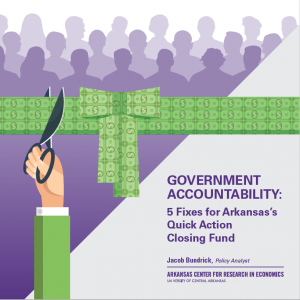The Quick Action Closing Fund (QACF) is a targeted economic development incentive program the state of Arkansas uses to try to increase economic activity. This program allows the state government to give cash grants to attract or retain businesses. It’s largely up to the Governor of Arkansas to approve these cash grants. The Arkansas Economic Development Commission (AEDC) claims that the QACF has created 26,684 jobs, but research from the Arkansas Center for Research in Economics provides evidence that there’s no statistically meaningful relationship between private employment and QACF subsidies. Questions regarding the program’s effectiveness aside, Arkansas lawmakers can take steps to improve the transparency and accountability of the program. Government Accountability: 5 Fixes for Arkansas’s Quick Action Closing Fund, a policy review written by ACRE Policy Analyst Jacob Bundrick, looks at five different policy proposals that could accomplish these goals.
The first way this program could be improved is through improved reporting standards. At the end of every year, the AEDC provides a report detailing the state’s use of the QACF. This report includes some useful information, but it could be improved. The report does not require the AEDC to list which companies signed a job-creation agreement and which ones did not. The capital investment for each company is omitted, which would detail how much the company is investing in the local economy. Wage data is missing, which would allow individuals to examine the expected benefit of each job promised. Most importantly though, the report does not include any information related to each company’s progress toward reaching their jobs, investment, or wage growth promises.
Another way this program could be made more accountable is to make “clawback” formulas public and void of re-negotiations. Since the QACF provides up-front cash grants and some businesses fail and do not meet their target, they must pay back some portion of the cash grant they received. However, the clawback formula for each company is not public, and often these clawbacks are renegotiated. When the penalty for failing with taxpayer money provided by these cash grants are weak or unenforced, it makes the protections taxpayers have from the clawback agreements extremely limited.
A third way the program could be improved is by limiting the amount of the cash granted on a per-job basis. In many instances today, states get into bidding wars to compete for businesses, and total price tag for these projects increase. Unfortunately, this can result in the project receiving more money from the state than it brings in economic benefit. Capping these grants is a common feature of other state incentive programs, and prevents this situation from happening.
A fourth way to improve the accountability of the program is to give out subsidies as targets are met. Currently, cash grants are given out up front. Clawback agreements can sometimes prevent a situation where projects fail, but sometimes they don’t help, such as in cases of bankruptcy. In these cases, if the cash grants were given out as goals were achieved, the risk of losing money on the investment would be minimized, as the state wouldn’t pay out the grants until the project’s goals were achieved.
A final way to improve the program is to cap the total number of QACF projects in a given year. Ideally only the best projects would be given QACF funding each year. One way we could encourage this is by capping the total number of projects. By capping the total number, the Governor and legislators must think very carefully about which programs to fund. It creates an incentive for the governor and legislature to only approve the very best projects, thereby decreasing the risk to taxpayers and increasing the expected benefits to the economy.
For a one-page summary of Bundrick’s research on the QACF, go here. The full text of the policy review can be found here.
You can find more of our research related to this topic here.

